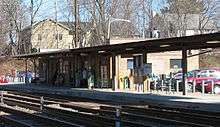Paoli station
Paoli station is a passenger rail station located in the western suburbs of Philadelphia at 13 Lancaster Avenue (US 30), Paoli, Pennsylvania.[5] It is served by Amtrak's Keystone Service and Pennsylvanian trains, and most SEPTA Paoli/Thorndale Line trains. The station has Amtrak and SEPTA ticket offices, a waiting room, vending machines, restrooms, and a coffee shop. The one-story tan brick building was constructed by the Pennsylvania Railroad in 1953 at a cost of $140,000; it replaced an earlier Victorian depot built in 1893.[6]
 Paoli station in 2020 | |||||||||||||||||||||||||||||||||||||
| Location | 13 East Lancaster Avenue, Paoli, Pennsylvania | ||||||||||||||||||||||||||||||||||||
| Coordinates | 40.04295°N 75.4837°W | ||||||||||||||||||||||||||||||||||||
| Owned by | Amtrak[1] | ||||||||||||||||||||||||||||||||||||
| Operated by | Amtrak & SEPTA | ||||||||||||||||||||||||||||||||||||
| Line(s) | Keystone Corridor (Main Line) | ||||||||||||||||||||||||||||||||||||
| Platforms | 1 island platform | ||||||||||||||||||||||||||||||||||||
| Tracks | 2 | ||||||||||||||||||||||||||||||||||||
| Connections | |||||||||||||||||||||||||||||||||||||
| Construction | |||||||||||||||||||||||||||||||||||||
| Parking | 486 spaces (177 daily, 309 permit) | ||||||||||||||||||||||||||||||||||||
| Bicycle facilities | 4 racks (8 spaces) | ||||||||||||||||||||||||||||||||||||
| Disabled access | Yes | ||||||||||||||||||||||||||||||||||||
| Other information | |||||||||||||||||||||||||||||||||||||
| Station code | Amtrak code: PAO | ||||||||||||||||||||||||||||||||||||
| Fare zone | 4 (SEPTA) | ||||||||||||||||||||||||||||||||||||
| History | |||||||||||||||||||||||||||||||||||||
| Opened | 1893 | ||||||||||||||||||||||||||||||||||||
| Rebuilt | 1953 | ||||||||||||||||||||||||||||||||||||
| Electrified | September 11, 1915[2] | ||||||||||||||||||||||||||||||||||||
| Traffic | |||||||||||||||||||||||||||||||||||||
| Passengers (FY 2018) | 233,816[3] | ||||||||||||||||||||||||||||||||||||
| Passengers (2015) | 717,053[4] (SEPTA) | ||||||||||||||||||||||||||||||||||||
| Services | |||||||||||||||||||||||||||||||||||||
| |||||||||||||||||||||||||||||||||||||
| |||||||||||||||||||||||||||||||||||||
This station is 19.9 miles (32.0 km) track from Philadelphia's Suburban Station.
Paoli Intermodal Transportation Center Project

The Paoli Intermodal Transportation Center (ITC) Project was proposed as a relocation and expansion of the Paoli station to a new site near the existing facility.[7] Improvements in the plans for the new intermodal transportation center included a bridge over the rail tracks (Darby Road which will replace Valley Road), renovation or replacement of the existing station building, new passenger waiting and ticketing facilities, passenger amenities, bus, shuttle, passenger parking facilities, and potential new retail and commercial business development.[8]
Construction for the first phase of the upgraded station commenced in February 2017.[9][10] The first phase, which cost $48 million, made the station compliant with the Americans with Disabilities Act by replacing the two low-level side platforms with a high-level island platform, constructing a pedestrian overpass over the tracks, and adding elevators and ramps. A ribbon-cutting ceremony for the first phase of the project was held on September 23, 2019, with Amtrak and SEPTA officials, disability rights groups, and area politicians in attendance. The second phase of the station project will replace the North Valley Road bridge. The third phase will turn the station into an intermodal transportation facility by constructing a high-level side platform adjacent to the outbound track, additional amenities for passengers, bus depot facilities, and a parking garage.[11]
Other future plans
The canceled light rail Greenline would have connected Paoli station with the towns of Phoenixville and Oaks, Pennsylvania.[12]
Station layout
Paoli has one center high-level island platform with an overpass allowing passengers to travel from the center platform to the ground level. Some SEPTA trains terminate/originate here. Originally, the station had four tracks, however the center tracks were removed in 2017 to allow for the construction of the center high-level platform.
| G | Street level | Exit/entrance, parking, and ticket office |
| P Platform level | ||
| Track 4 | ← Paoli/Thorndale Line toward Malvern or Thorndale (Malvern) ← Keystone Service toward Harrisburg (Exton) ← Pennsylvanian toward Pittsburgh (Lancaster) | |
| Island platform, doors will open on the left | ||
| Track 1 | Pennsylvanian toward New York (Philadelphia) → Keystone Service toward Philadelphia or New York (Ardmore) → Paoli/Thorndale Line toward Suburban Station or Temple University (Daylesford) → | |
Further reading
- History of the Paoli Station (PDF). Pennsylvania Department of Transportation. 2019. Archived (PDF) from the original on 14 May 2019.
References
- "Transportation Planning for the Philadelphia–Harrisburg "Keystone" Railroad Corridor" (PDF). Federal Railroad Administration. Archived from the original (PDF) on May 21, 2011. Retrieved 9 January 2013.
- Tatnall, Frank (Fall 2015). "A Century of Catenary". Classic Trains. 16 (3): 26.
- "Amtrak State Fact Sheet, FY2018, Commonwealth of Pennsylvania" (PDF). Amtrak. June 2019. Retrieved 28 December 2019.
- "2015 Regional Rail Census". SEPTA.
- "Google Maps".
- "Paoli Station". Amtrak's Great American Stations. Retrieved 3 November 2014.
- "About The Project". Paoli Intermodal Transportation Center. SEPTA. Archived from the original on 2014-12-17. Retrieved 2014-12-17.
- "Fact Sheet -- Paoli Station Accessibility Improvement Project" (PDF). Plan the Keystone. Pennsylvania Department of Transportation. Retrieved 2014-12-17.
- Bond, Michaelle (28 February 2017). "Amtrak, SEPTA chug toward full wheechair access with Paoli upgrades". Philly.com. Retrieved 4 March 2017.
- "Paoli Station Accessibility Improvements - nec.amtrak.com".
- Bannan, Pete (September 24, 2019). "Ribbon-cutting held for Paoli train station project; Dinniman calls for Amtrak to move on other stations". Delaware County Daily Times. Retrieved September 24, 2019.
- "Citizens for the Train". Citizens for the Train. 2014. Archived from the original on 1 February 2014.
External links
| Wikimedia Commons has media related to Paoli (SEPTA station). |